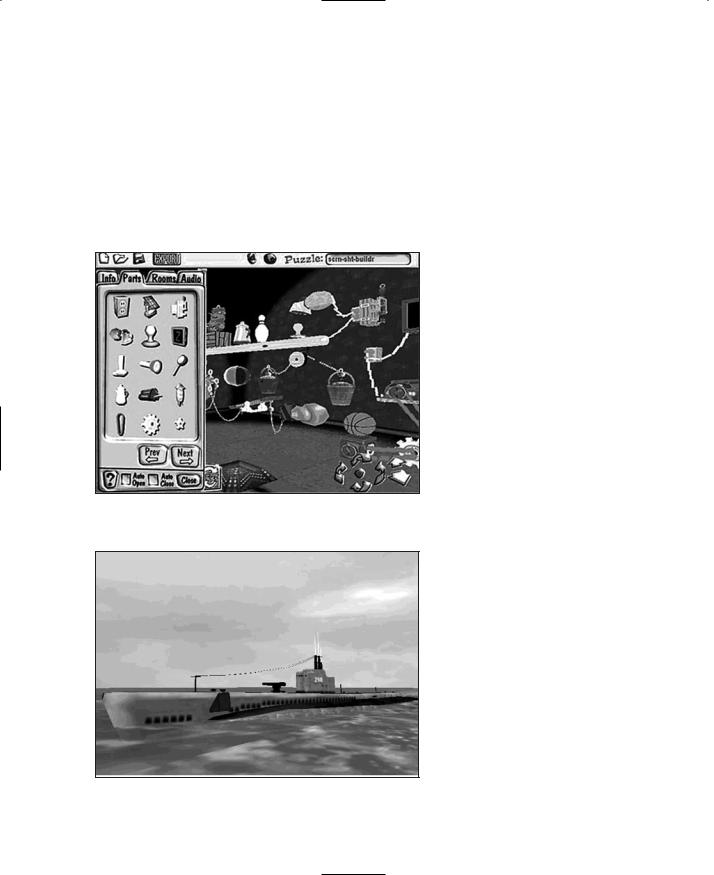
3D Game Programming All In One (2004)
.pdf
xxxIntroduction
Sound and Music
After modeling, you will encounter the icing on the game cake: sound and music. You will discover how to select, create, and modify sounds for use in your game. You will also get some advice about selecting musical themes and how to integrate music into your game.
Integration
After picking up the required programming skills, and learning how to use the art creation and modeling tools, you will learn how to knit all the parts together to create a game, populate your game world, and then test and troubleshoot your game. Finally, we look at where you can go with your shiny new 3D game developer’s toolkit of ideas, knowledge, skills, and software tools.
The Companion CD
The companion CD contains quite a few resources. Following is a quick description. For more detail, check the appendixes.
Source Code
The book’s CD contains all of the Torque Script source code in sample form and final form. The samples will be aligned with the exercises in each chapter. The scripts for the final completed game will be included in its own directory tree. The game will be usable immediately upon installation from the CD so that you can have an instant and extensive preview of what is to come.
Game Engine
The CD will contain the complete Torque Game Engine with its executable, DLLs, and all required GUI and support files. It is a fully featured game engine that includes advanced networking capabilities, blended animations, built-in server-side anticheat capabilities, BSP support, a strong and complete object-oriented C++-like scripting language, and many other advanced features.
Tools
The following shareware tools are included on the CD:
■MilkShape 3D for 3D player and item modeling
■QuArK for 3D interior modeling
■Paint Shop Pro for texture and image manipulation
■Audacity for sound editing and recording
■UVMapper to perform UV unwrapping tasks
■UltraEdit-32 as the text or programming editor
Team LRN

Introduction xxxi
Goodies
The CD also includes a few extras that aren’t mentioned in the book or that are only briefly touched on:
■Retail games created with Torque: Orbz, ThinkTanks, Marble Blast, Chain Reaction
■Additional image and audio libraries
■Open Source utility source code
Go Get ’em!
The most important asset you have as an independent, and the key to any success, is your enthusiasm. Remember to use this book, and other books and training you acquire, as resources that will help you do what you want to do; they are not vouchers that you can trade in for a nice big pot of success. You have to do the work in the learning, and you have to do the work in the creating. And I know you can! Go get ’em!
Team LRN
This page intentionally left blank
Team LRN

chapter 1
Introduction to
3D Game Development
Before we get into the nitty-gritty details of creating a game, we need to cover some background so that we can all work from the same page, so to speak. In the first part of this chapter, we will establish some common ground regarding the 3D
game industry in the areas that matter—the types of games that are made and the different roles of the developers that make them. In the second part of the chapter, we'll establish what the essential elements of a 3D game are and how we will address them.
Throughout the book you will encounter references to different genres, or types, of games, usually mentioned as examples of where a particular feature is best suited or where a certain idea may have originally appeared. In this chapter we will discuss the most common of the 3D game genres. We will also discuss game development roles; I will lay out "job descriptions" for the roles of producer, designer, programmer, artist, and quality assurance specialist (or game tester). There are various views regarding the lines that divide the responsibilities so my descriptions are fairly generic.
Finally, we will discuss the concept of the 3D game engine. If ever there is going to be an area of dispute between a writer and his readers in a book like this, a discussion of what constitutes a 3D game engine will be it. I do have a trump card, though. In this book we will be using the Torque Game Engine as our model of what constitutes a fully featured 3D game engine. We will use its architecture as the framework for defining the internal divisions of labor of 3D game engines.
The Computer Game Industry |
|
The computer game industry is somewhat different than other high-tech fields. The busi- |
|
ness operates more like Hollywood than traditional commercial or industrial software |
|
development; there are properties, producers, artists, and distributors. This industry has |
1 |
|
Team LRN

2 Chapter 1 ■ Introduction to 3D Game Development
its own celebrities. It is quite a bit more informal and relaxed than other high-tech fields in many ways but is quicker paced with a higher burnout rate. There are independent game developers, or indies, and big-name studios, but the computer game industry tends to be more entrepreneurial in spirit.
Just as in the motion picture industry, an indie developer is one that is not beholden to other businesses in their industry that can direct their efforts. Indies fund their own efforts, although they sometimes can get funding from outside sources, like a venture capitalist (good luck finding one). The key factor that makes them independent is that the funding does not come from downstream industry sources that would receive the developer's product, like a major game development house, publisher, or distributor.
Indies sell their product to distributors and publishers after the product is complete, or nearly so. If a developer creates a product under the direction of another company, they are no longer independent.
A good measure of the "indie-ness" of a developer is the answer to the following two questions:
■Can the developer make any game he wants, in whatever fashion he wants?
■Can the developer sell the game to whomever he wants?
If the answer is "yes" in both cases, then the developer is an indie.
Of course, another strong similarity with movies is that, as I pointed out earlier, games are typically classified as belonging to different genres.
3D Game Genres and Styles
Game development is a creative enterprise. There are ways to categorize the game genres, but I want you to keep in mind that while some games fit each genre like a glove, many others do not. That's the nature of creativity. Developers keep coming up with new ideas; sometimes they are jockeying for an advantage over the competition and sometimes they are just scratching an itch. At other times, calculating marketing departments decide that mixing two popular genres is a surefire path to a secure financial future.
The first rule of creative design is that there are no rules. If you are just scratching an itch, then more power to you. If you are looking to make a difference in the gaming world, you should at least understand the arena. Let's take a look at the most common 3D genres around today and a few that are interesting from a historical perspective. When you are trying to decide what sort of game you want to create, you should try understanding the genres and use them as guides to help focus your ideas.
It's important to note that all of the screen shots in this chapter are of games by indie game developers. Some of the games are currently being shipped as retail games, and
Team LRN

The Computer Game Industry |
3 |
some are still in development. Almost all of them use the same Torque Game Engine we will use in this book to develop our own game.
By no means is this a definitive list; there are many genres that don't exist in the 3D gaming realm, and the number of ways of combining elements of genres is just too large to bother trying to enumerate. If you take pride in your creativity, you might resist attempts to pigeonhole your game idea into one of these genres, and I wouldn't blame you. When trying to communicate your ideas to others, however, you will find it useful to use the genres as shorthand for various collections of features, style, and game play.
Action Games
Action games come in several forms. The most popular are the First-Person Point-of-View (1st PPOV) games, where your player-character is armed, as are your opponents. The game play is executed through the eyes of your character. These sorts of games are usually called First-Person Shooter (FPS) games. Game play variations include Death Match,
Capture the Flag, Attack & Defend, and King-of-the-Hill. Action games often have multiplayer online play, where your opponents are enemies controlled by real people instead of by a computer. Success in FPS games requires quick reflexes, good eye-hand coordination, and an intimate knowledge of the capabilities of your in-game weapons. Online FPS games are so popular that some games have no single-player game modes.
Some action games are strictly 3rd PPOV, where you view your player-character, or avatar, while also viewing the rest of the virtual world your avatar inhabits (see Figure 1.1).
Half-Life 2, Rainbow Six, and Delta Force: Blackhawk Down are popular examples of FPSstyle action games.
Adventure Games
Adventure games are basically about exploring, where playercharacters go on a quest, find things, and solve puzzles. The pioneering adventure games were text based. You would type in movement commands, and as you entered each new area or room, you would be given a brief description of where you were. Phrases like "You are in a maze of twisty passages, all alike" are now gaming classics. The best
Figure 1.1 Think Tanks—a 3rd PPOV action game made by BraveTree Productions using the Torque Game Engine.
Team LRN

4Chapter 1 ■ Introduction to 3D Game Development
adventure games play like interactive books or stories, where you as the player decide what happens next, to a certain degree.
Text adventures evolved into text-based games with static images giving the player a better idea of his surroundings. Eventually these merged with 3D modeling technology. The player was then presented with either a firstor third-person point of view of the scene his character was experiencing.
Adventure games are heavily story based and typically very linear. You have to find your way from one major accomplishment to the next. As the story develops, you soon become more capable of predicting where the game is going. Your success derives from your ability to anticipate and make the best choices.
Some well-known examples of adventure games are The King's Quest series, The Longest Journey, and Syberia.
Online adventure games have not really come into their own yet, although some games are emerging that might fit the genre. They tend to include elements of FPS action games and Role-Playing Games (RPGs) to fill out the game play, because the story aspect of the game is more difficult to accomplish in an online environment. Players advance at different speeds, so a monolithic linear story line would become pretty dreary to a more advanced player. An example of an online action-adventure-FPS hybrid game is Tubettiworld (see Figure 1.2), being developed by my all-volunteer team at Tubetti Enterprises.
Role-Playing Games
Role-playing games are very popular; that popularity can probably find its roots in our
Figure 1.2 Tubettiworld—an action-adventure FPS hybrid game being developed by Tubetti Enterprises using the Torque Game Engine.
early childhood. At younger than age six or seven, we often imagined and acted out exciting adventures inspired by our action figures and other toys or children's books. As was also true for strategy games, the more mature forms of these games first evolved as pen-and- paper games, such as Dungeons & Dragons.
These games moved into the computer realm with the computer taking on more of the data-manipulation tasks of the game masters. In role-playing games, the player is usually
Team LRN

The Computer Game Industry |
5 |
responsible for the development of his game character's skills, physical appearance, loyalties, and other characteristics. Eventually the game environment moved from each player's imaginations onto the computer, with rich 3D fantasy worlds populated by visually satisfying representations of buildings, monsters, and creatures (see Figure 1.3). RPGs are usually science fiction or fantasy based, with some historically oriented games being popular in certain niches.
Maze and Puzzle Games
Figure 1.3 Myrmidon—a science fiction RPG, another Torque-based game, being developed by 21-6 Productions.
Maze and puzzle games are somewhat similar to each other. In a maze game you need to find your way through a "physical" maze in which your routes are defined by walls and other barriers. Early maze games were 2D, viewed from the top; more recent ones play more like 3D adventure or FPS games.
Puzzle games are often like maze games but with problems that need to be solved, instead of physical barriers, to find your way through.
Mazes also make their appearance in arcade pinball-style games such as Marble Blast (see Figure 1.4) by GarageGames. It is a maze-and-puzzle hybrid game where you compete against the clock in an effort to navigate a marble around physical barriers. The puzzle aspect lies in determining the fastest (though not necessarily the most direct) route to the finish line.
Puzzle games sometimes use puzzles that are variations of the shell game or that are more
Figure 1.4 Marble Blast—a maze-and-puzzle hybrid game by GarageGames using its Torque Game Engine.
Team LRN

6Chapter 1 ■ Introduction to 3D Game Development
indirect problem-solving puzzles where you must cause a series of things to happen in order to trigger some further action that lets you advance. Many puzzle games utilize direct prob- lem-solving modes where the puzzle is presented visually. You then need to manipulate onscreen icons or controls in the correct sequences to solve the problem. The best puzzles are those where the solution can be deduced using logic. Puzzles that require pure trial-and- error problem-solving techniques tend to become tedious rather quickly. A historic example of a puzzle game is The Incredible Machine series by Dynamix. The latest variation of this type is the new game Chain Reaction by Monster Studios (see Figure 1.5).
Figure 1.5 Chain Reaction—a puzzle game by Monster Studios using its Reaction Engine.
Figure 1.6 Center World—a submarine sim in development by Michael Hense, an independent game developer, using the Torque Game Engine.
Simulator Games
The goal of a simulator (or sim) game is to reproduce a realworld situation as accurately as possible. The measure of the simulation accuracy is usually called its fidelity. Most simulators put a heavy emphasis on the fidelity of the visual appearance, sounds, and physics of the game.
The point is total immersion in the game environment, so that you get the feeling you are actually there. You may be flying a jet fighter or driving a thoroughbred Grand Prix racing car. The game mirrors the reallife experience to the maximum the developers can manage.
Simulators usually require specialized input devices and controllers, such as aircraft joysticks and rudder pedals. Many simulator enthusiasts build complete physical cockpit mockups to enhance the immersion experience.
Falcon 4, Grand Prix Legends, and Center World (see Figure 1.6) are examples of simulator games.
Team LRN

7
Sports Games
Sports games are a variation of the simulator class of games in which the developer's intent is to reproduce the broad experience of the game as accurately as possible. You can participate in a sports game at various levels and watch the action play out in a realistic 3D environment (see Figure 1.7).
Unlike the action-oriented flight and driving simulators, sports games usually have a manager or season angle. While playing the game, you can also take on the role of
coach, owner, or team manager. You can execute draft picks and trades or groom new players like any major league ball organization would. In a modern sports simulator you could be managing budgets, and you might play or race a regular year's schedule, playing in different stadiums or arenas or racing on different tracks.
Strategy Games
Strategy games began as pen-and-paper games, like war games, that have been around for centuries. As computer technology evolved, computer-based tables and random-number generators replaced the decision-making aspects of strategy games traditionally embodied by lookup charts and dice rolls.
Eventually the tabletop battlefields (or sandbox battlefields) with their cardboard markers or die-cast military miniatures moved into the computers as well. The early tabletop games were usually turn based: Each player would in turn consider his options and issue "orders" to his units. Then he would throw the dice to determine the result of the orders. The players would then modify the battlefield based upon the results. After this, the players would observe the new shape of the battlefield and plot their next moves. The cycle then repeated itself.
The advent of computer-based strategy games brought the concept of real time to the forefront. Now the computer determines the moves and results and then structures the battlefield accordingly. This has given birth to the Real-Time Strategy (RTS) genre. It does this on a time scale that reflects the action. Sometimes the computer will compress the time scale, and other times the computer will operate in real time, where one minute of
Team LRN
